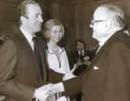Alejo Carpentier
Alejo F. Carpentier Valmont, a novelist, critic, essayist, publicist, scholar in topics as compared ethnology and mythology, music, plastic arts, architecture, mass media; a traveler of the world, of the Caribbean, of the jungle of the Americas, was born in Havana in 1904, his parents who were Russian and French, respectively, came to Cuba in 1902, because his father had “set his eyes on the Americas”.
Carpentier lived eleven years in France and fourteen in Caracas, he traveled along several regions, but he always returned to Havana, a city he knew very well and regarded as a fabulous setting for novels. In one of his transcendental novels El siglo de las luces (translated into English as Explosion in a Cathedral) the characters lived in 18th-century Havana.
Historic and Real Facts in Carpentier's Work
In Carpentier's accounts, fiction is based on a search process carried out in sources, museums, libraries and archives from which names, events and engravings are found and used by his creative imagination, as the writer stated: “My subjective cosmos is just the recreation of reality. All the elements are provided....”
In 1933, he stated to have spent almost eight years reading texts on the Americas since he had the obscure intuition that his work will be centered around it, deeply dedicated to this region.
The Marvelous Reality of the Americas
In an interview granted by Carpentier, on the occasion of the publication of his novel El recurso del método ( translated into English as Reasons of State), he stated: “The things never said, the words never pronounced should be searched in the Americas....”
Alejo Carpentier traveled to Haiti in 1943 in the company of Louis Jouvet, he also traveled to Upper Orinoco and the Amazonas territory. His travels along with his research work, made him see the possibilities opened up for the production of a Latin-American novel with new approaches.
He discovered a marvelous reality in itself, without forcing the creative imagination. Carpentier expounds the marvelous reality in the Americas¾in his work and theory¾as an authentic vision of reality, a view of the world, opposed to the European magic realism.
The Kingdom of this World
Carpentier published in 1949 Explosion in a Cathedral, a captivating account derived from his visit to Haiti. The prologue of his book explains the essence of his concept of “marvelous reality of the Americas”.
“At every step, I found the marvelous reality realm, but at the same time I thought that the presence and permanence of the 'marvelous reality' was not the sole privilege of Haiti, but the heritage of the Americas as a whole....But what is the history of the Americas about, but a chronicle of the marvelous reality?”
Carpentier contends that the Latin-American novelist to be able to express this “marvelous reality” has to resort to “a vocabulary, not necessarily one that typifies, but rather one that makes use of metaphors, abundant images and colors, baroque, especially baroque to express the marvelous world of the Americas”. He added some years later that “to define, paint, describe a new world, unknown trees, overwhelming vegetation, mighty rivers, one always is baroque.”
The Races of Art Makers Alejo Carpentier, a Cuban who covered with glory the Latin-American and Caribbean Letters, died in France when he was holding the position of cultural attaché in the Embassy of the Republic of Cuba to France. Nonetheless his cultural legacy, especially his theory on the marvelous reality of the Americas continues being subject to deep research and analysis and the essence, consciously or unconsciously, of the vast literary production in the region.






































































